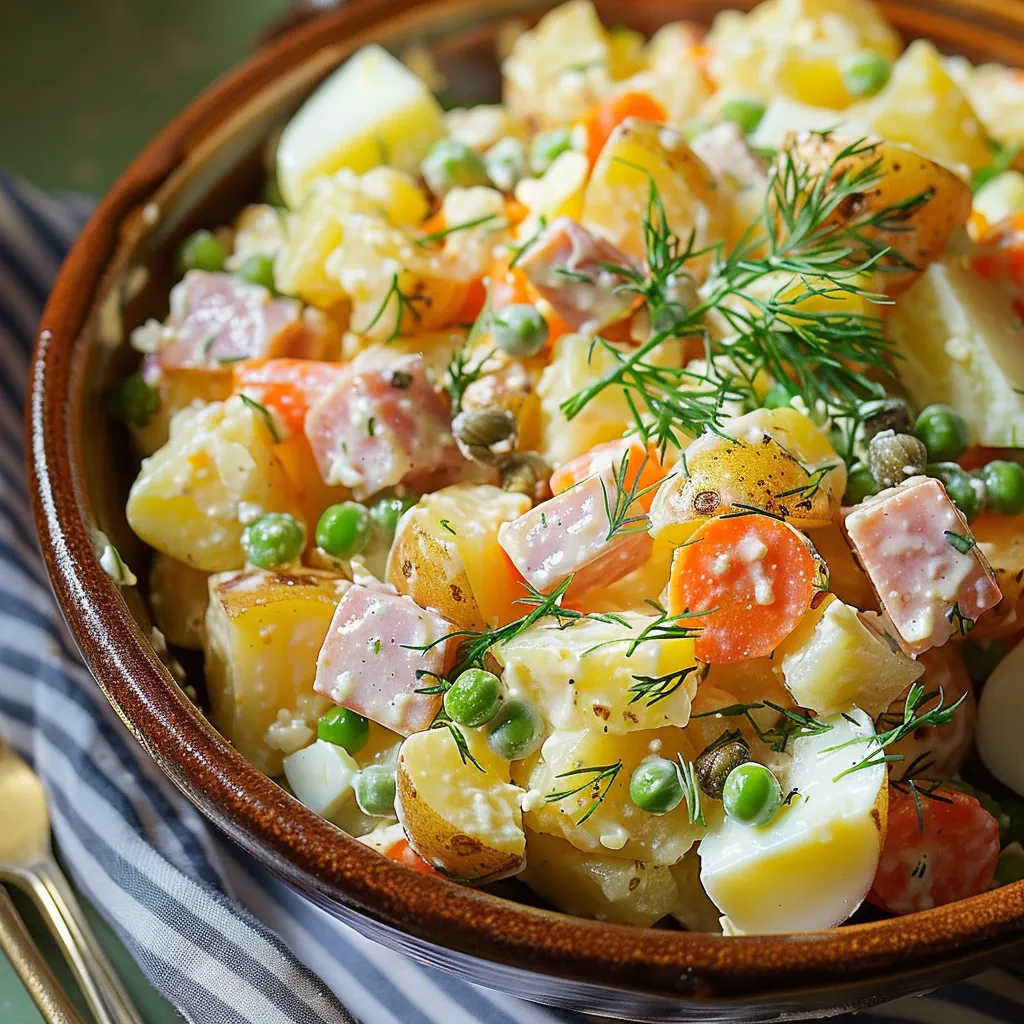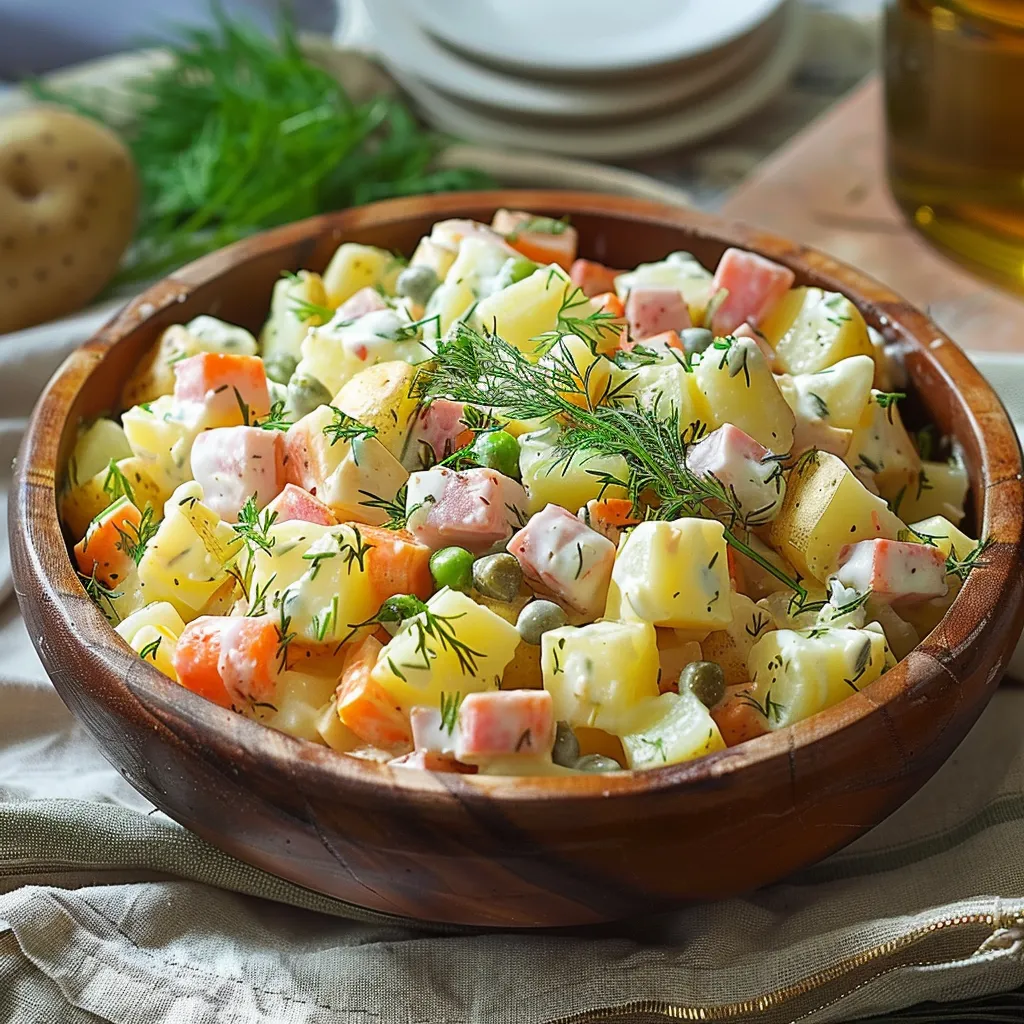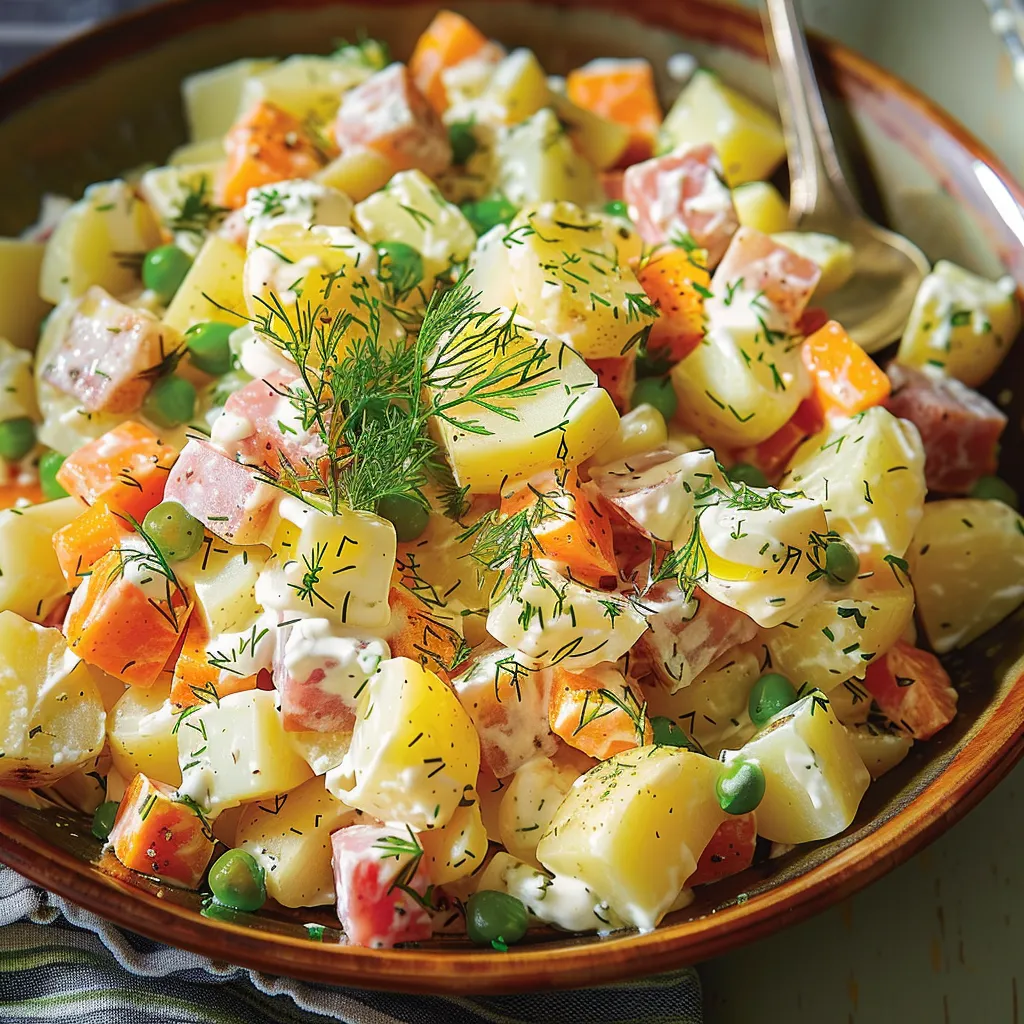 Pin to Favorites
Pin to Favorites
Olivier Potato Salad delivers a vibrant, flavor-packed twist on traditional potato salad that will forever change how you think about this classic side dish. Far from bland boiled potatoes drowning in mayonnaise, this Eastern European treasure combines tender Yukon gold potatoes with crisp-tender vegetables, hard-boiled eggs, and bright herbs all bound together with a tangy dressing that perfectly balances creamy and acidic notes. Each forkful offers a delightful medley of textures and flavors that elevates this humble dish to star status at any gathering.
Last summer I brought this to a neighborhood potluck where it was placed alongside three other potato salads. By the end of the evening, mine was the only bowl completely emptied. The secret lies in the perfect balance of ingredients and the bright, tangy dressing that ties everything together without overwhelming the individual components.
Essential Ingredients and Selection Tips
- Yukon Gold Potatoes: Their naturally buttery flavor and waxy texture hold up beautifully in salads without falling apart
- Fresh English Peas: When in season, these add incomparable sweetness and a satisfying pop. Frozen work wonderfully in the off-season
- Capers: These little flavor bombs add briny, tangy notes that wake up the entire dish
- Fresh Dill: The feathery herb adds brightness that ties all the ingredients together. Accept no substitutes here
 Pin to Favorites
Pin to Favorites
I've found that using waxy potatoes like Yukons makes a significant difference in the final texture. My first attempts with russet potatoes resulted in a mushier salad as they broke down more during mixing. The firmer texture of Yukons maintains distinct pieces that hold the dressing beautifully.
Detailed Cooking Instructions
- Perfect Your Potato Preparation:
- Begin by bringing a medium to large pot of generously salted water to a boil—the water should taste like the sea. While waiting for the water to boil, peel your Yukon gold potatoes and cube them into uniform 1/2-inch pieces. Consistent sizing ensures even cooking, preventing some pieces from becoming mushy while others remain firm. Add the cubed potatoes to the boiling water and reduce to a gentle simmer, which prevents the potatoes from bouncing against each other and breaking apart. Cook until tender but still offering slight resistance when pierced with a fork, about 12 minutes. Drain thoroughly but do not rinse—the residual starch helps the dressing adhere. Spread the hot potatoes on a baking sheet to cool slightly and stop the cooking process, which preserves their texture.
- Master the Perfect Hard-Boiled Egg:
- Refill your pot with a few inches of water and carefully add the eggs, ensuring they're covered by about an inch of water. Bring to a boil over high heat. Once boiling, immediately cover the pot with a lid and remove from heat. This gentle cooking method prevents the gray ring around the yolk that comes from overcooking. Let the eggs sit in the hot water for exactly 12 minutes—set a timer for precision. Meanwhile, prepare an ice bath in a medium bowl. When the timer sounds, promptly transfer the eggs to the ice water using a slotted spoon. The thermal shock helps separate the shell from the membrane, making peeling easier. Let them cool completely, about 10 minutes, then peel and chop into pieces similar in size to your potato cubes for consistent texture throughout the salad.
- Cook Vegetables to Crisp-Tender Perfection:
- While the eggs are cooling, bring the pot of water back to a simmer for your vegetables. Add the diced carrots first, as they require longer cooking. Simmer for 4 minutes until they begin to soften but still offer some resistance when bitten. Then add the fresh or frozen peas and cook for just 1 more minute. The goal is vegetables that are no longer raw but maintain a slight crunch that contrasts beautifully with the softer potatoes and eggs. Immediately drain and spread on a plate to cool slightly, stopping the cooking process. This blanching technique preserves their bright color and prevents them from becoming mushy in the salad.
- Create a Balanced, Flavorful Dressing:
- In a large mixing bowl, whisk together 1/2 cup of mayonnaise, 1/4 cup of white wine vinegar, 2 tablespoons of drained capers, 1 tablespoon of Dijon mustard, 1 teaspoon of salt, and 1 teaspoon of freshly ground black pepper. The combination of creamy mayonnaise and acidic vinegar creates the perfect base, while the capers and mustard add complexity. Whisk until completely smooth and emulsified. This dressing should be slightly looser than standard mayonnaise but thick enough to coat the back of a spoon. The tanginess may seem strong when tasted alone, but it balances perfectly once combined with the other ingredients.
- Combine Components with Care:
- Add the cooled potatoes, chopped eggs, blanched carrots and peas, optional ham if using, and 2 tablespoons of minced fresh dill to the bowl with the dressing. Using a rubber spatula or large spoon, fold everything together with gentle movements rather than aggressive stirring. This preserves the integrity of each component while ensuring even distribution of the dressing. Continue folding just until everything is coated and combined—overmixing can break down the potatoes and eggs, creating a mushier texture. The salad should look substantial and colorful, with each ingredient distinct yet harmonious.
- Finish and Rest for Flavor Development:
- Once mixed, taste the salad and adjust seasoning if needed. Sometimes a bit more salt or pepper brings everything into perfect balance. Transfer to a serving bowl and garnish with additional fresh dill sprigs for visual appeal and a hint of what's to come. While delicious immediately, the salad benefits tremendously from at least an hour of resting time in the refrigerator, allowing flavors to meld and develop. For the very best result, make it a day ahead and refrigerate overnight, bringing it to room temperature for about 20 minutes before serving to take the chill off and allow the flavors to fully express themselves.
My first attempt at this salad taught me that cooking technique matters as much as ingredients. I initially overcooked both the potatoes and vegetables, resulting in a mushy texture despite the perfect flavor balance. Now I'm vigilant about cooking each component just until tender, preserving the delightful textural contrasts that make this salad special.
The Art of Cooking Potatoes
The foundation of this salad lies in properly cooked potatoes. I've discovered that starting potatoes in cold water leads to more even cooking from inside out. However, for this salad, adding cubed potatoes to already-boiling salted water works better as it helps them maintain their shape.
The cooking time varies slightly depending on your exact cube size, but the perfect potato cube should offer just slight resistance when pierced with a fork – think al dente pasta. Overcooked potatoes will crumble when mixed, while undercooked ones remain unpleasantly firm and starchy.
Vegetable Selection Strategies
While carrots and peas are traditional, I've experimented with other vegetables with great results. Blanched green beans cut into small pieces offer a similar bright color and satisfying crunch. In summer, I sometimes add corn kernels cut fresh from the cob for sweet bursts of flavor.
The key is maintaining the proper vegetable-to-potato ratio – about 1 part vegetables to 2 parts potatoes creates the ideal balance. Too many vegetables overwhelm the salad's foundation, while too few make it one-dimensional.
Make-Ahead Magic
One of this salad's greatest virtues is how it improves with time. The initial resting period allows the potatoes to absorb the dressing's flavors while the vinegar gently pickles the vegetables. After 24 hours in the refrigerator, all components have harmonized beautifully, creating a more cohesive dish than one served immediately.
For entertaining, I often make this salad up to two days ahead, keeping a small portion of the fresh dill aside to sprinkle just before serving. This gives the convenience of advance preparation with the fresh appearance of something just made.
I discovered these refinements through both happy accidents and deliberate experimentation, like the time I had leftover capers that I'd fried for another dish and added them to this salad. Their intensified flavor and crunchy texture elevated the dish to new heights.
This Olivier Potato Salad stands as proof that sometimes the simplest dishes, when made with care and quality ingredients, can outshine more complex culinary creations. The harmonious balance of creamy, tangy, crunchy, and fresh elements creates a side dish worthy of celebration. Whether served alongside grilled meats at a summer barbecue or as part of a holiday spread, this salad honors its historic roots while satisfying modern palates with its vibrant flavors and textures.
 Pin to Favorites
Pin to Favorites
Frequently Asked Questions
- → What makes Olivier Potato Salad different from American potato salad?
- Olivier Salad typically includes a wider variety of ingredients than American potato salad, particularly peas and carrots. It also often features capers and a more tangy dressing with white wine vinegar and Dijon mustard.
- → Can I make Olivier Potato Salad ahead of time?
- Yes, this salad is perfect for making ahead! The flavors actually improve after 24 hours in the refrigerator. It keeps well for up to 4 days when stored in an airtight container.
- → What can I substitute for ham in this potato salad?
- If you want to keep it vegetarian, simply omit the ham. For alternatives, try diced cooked chicken, turkey, or even smoked salmon. For a vegetarian protein option, diced firm tofu works well.
- → What's the best way to serve Olivier Potato Salad?
- Serve Olivier Salad chilled as a side dish with roasted meats, grilled chicken, or as part of a cold buffet. In Eastern Europe, it's traditionally served during holidays, especially New Year's celebrations.
- → Can I customize the vegetables in this Olivier Salad?
- Absolutely! While peas and carrots are traditional, you can add diced cucumber, pickles, apples, or bell peppers. Some versions also include diced beets or cooked beans for added color and nutrition.
